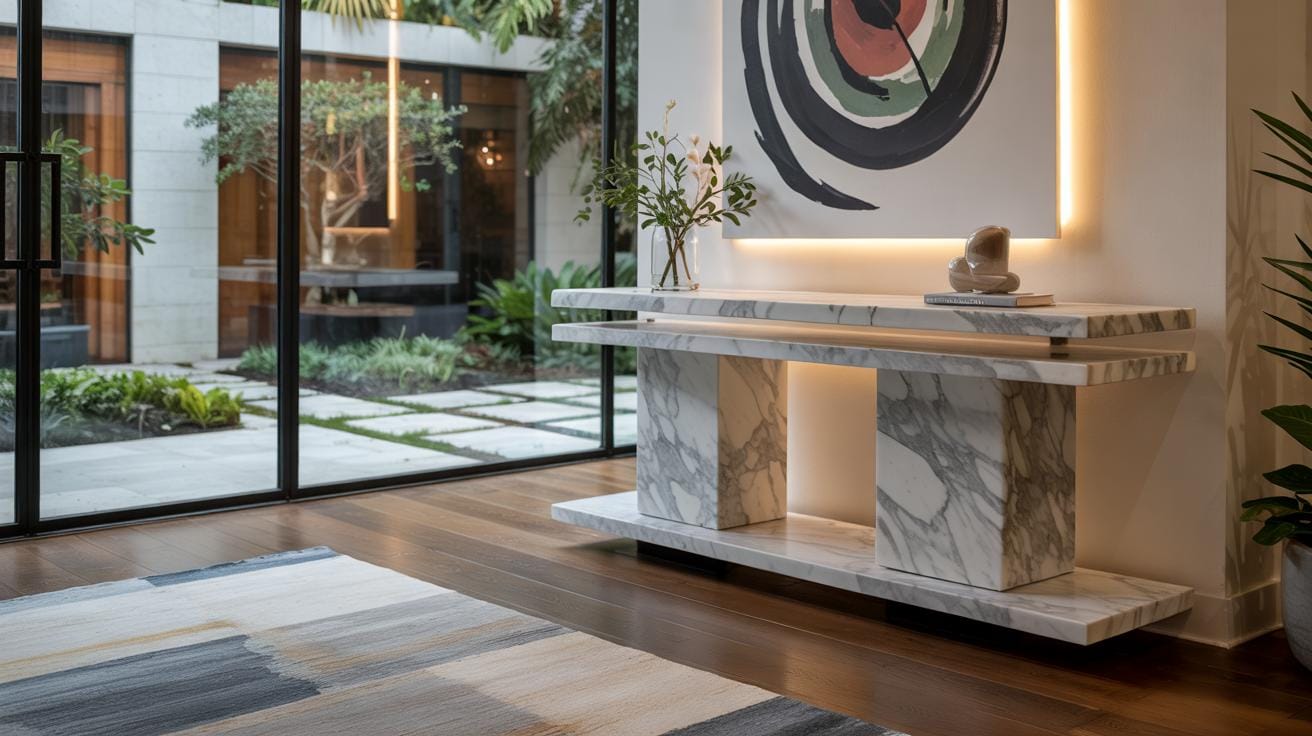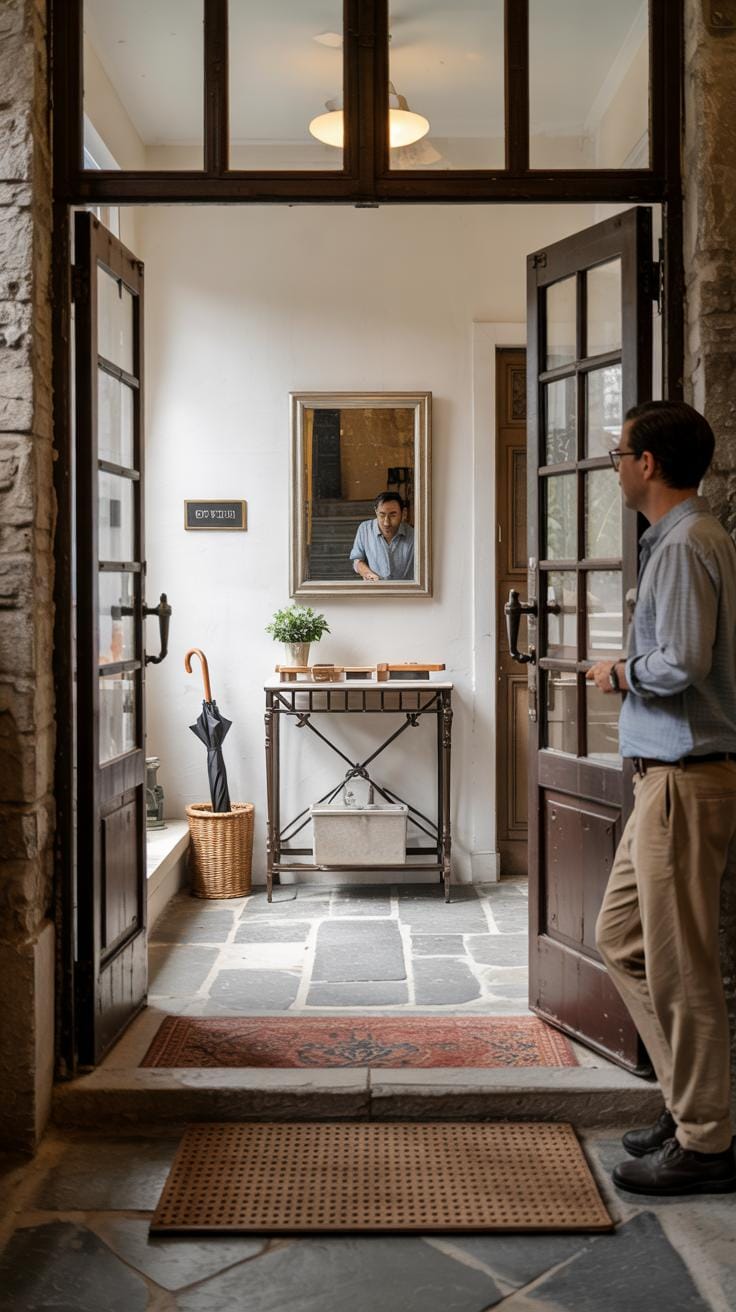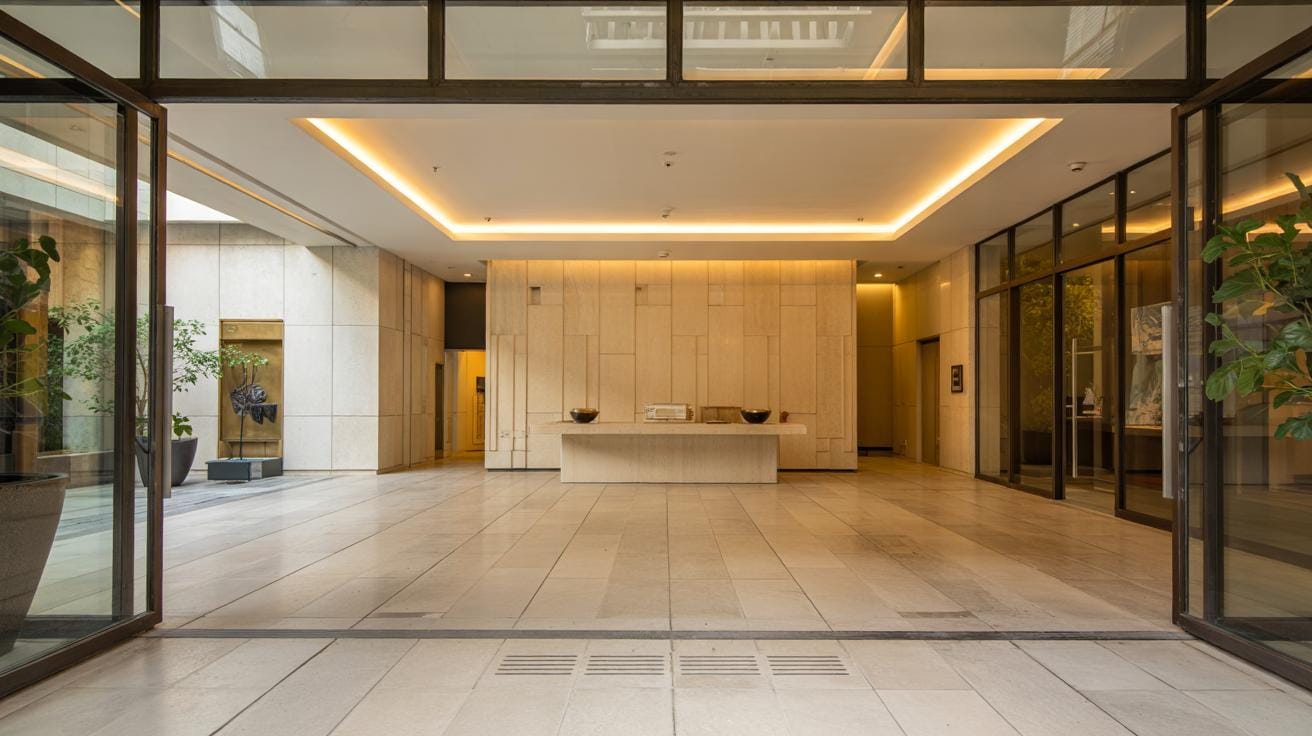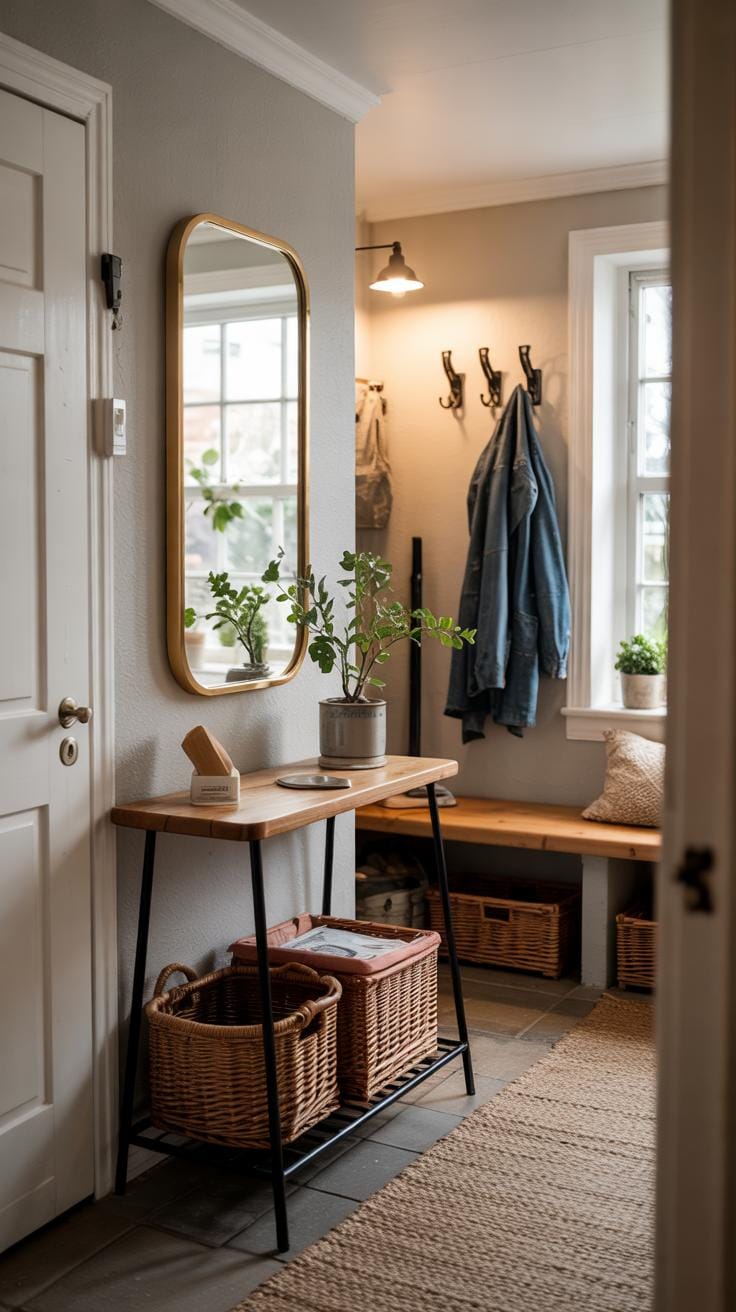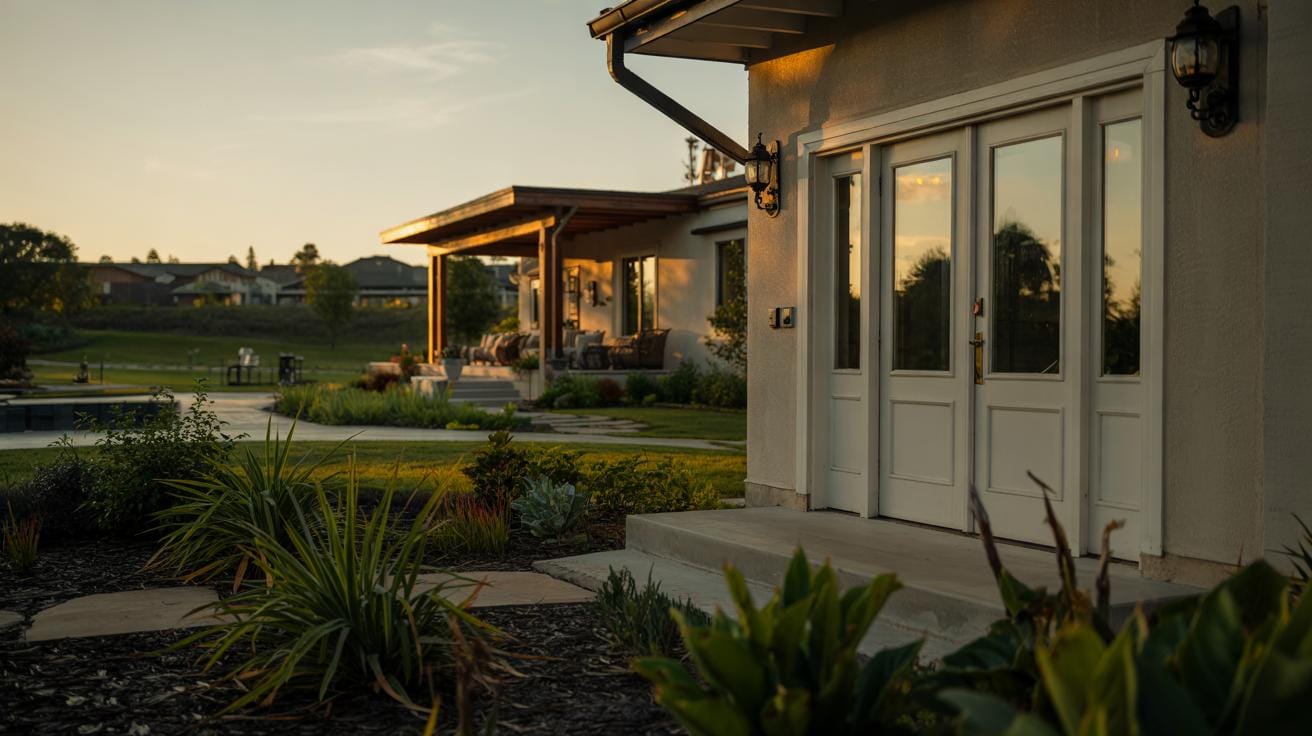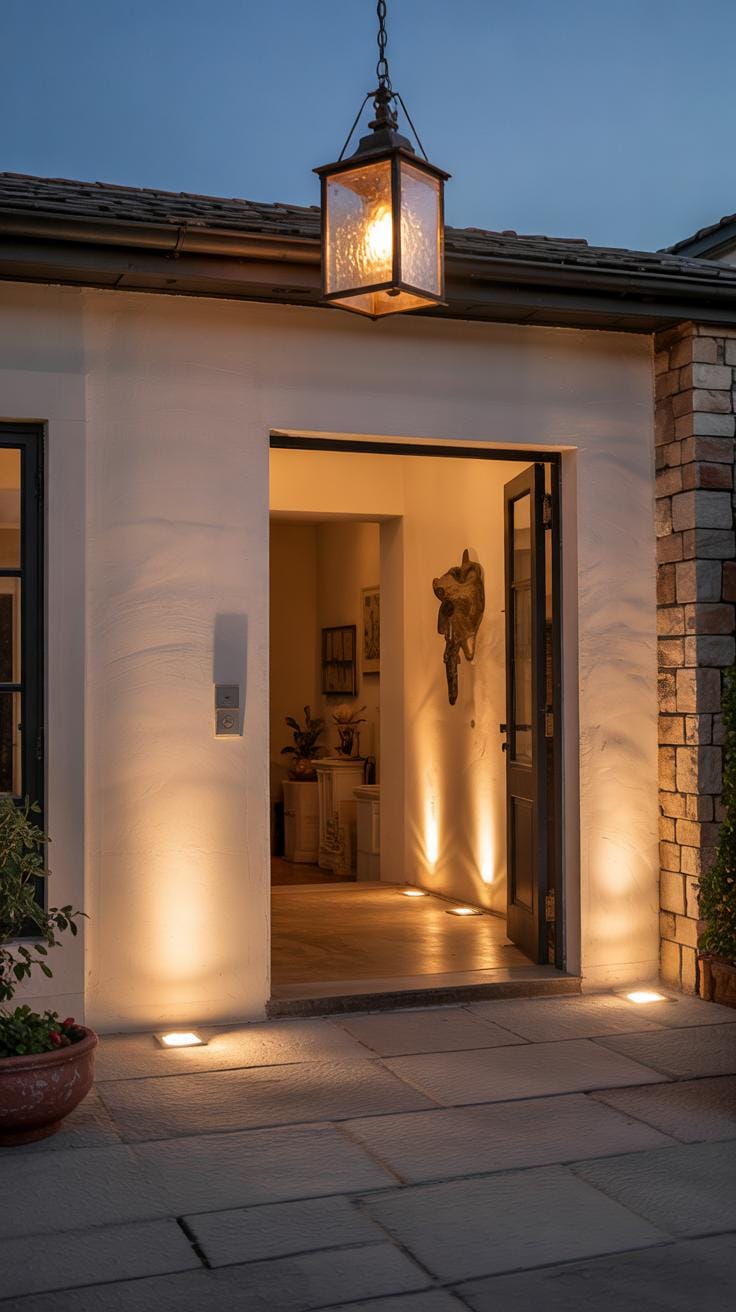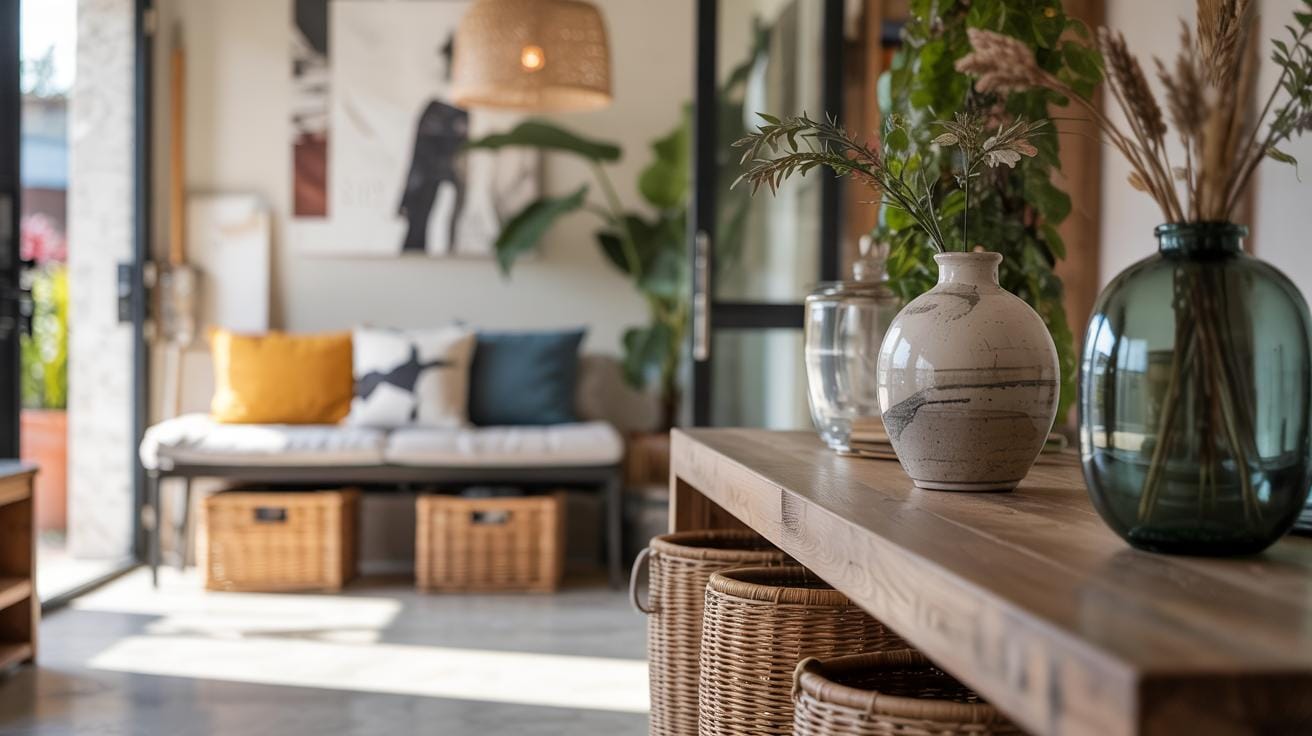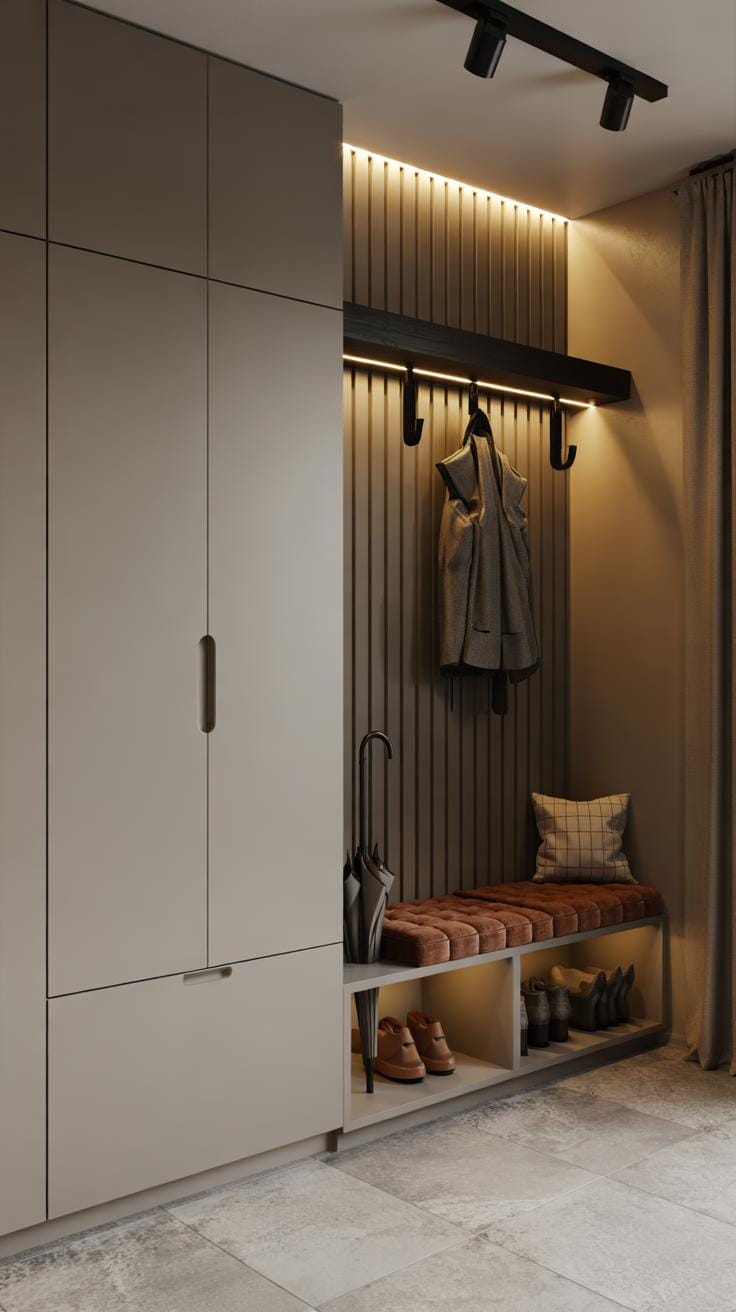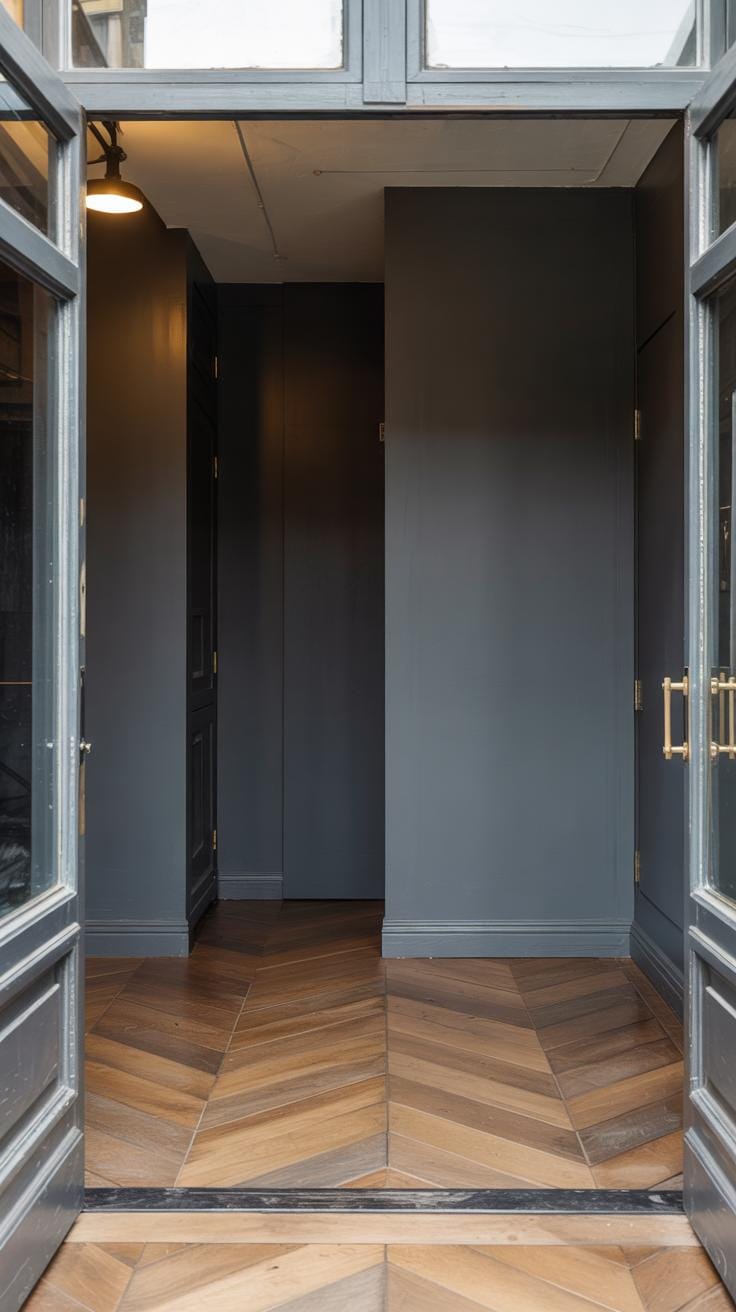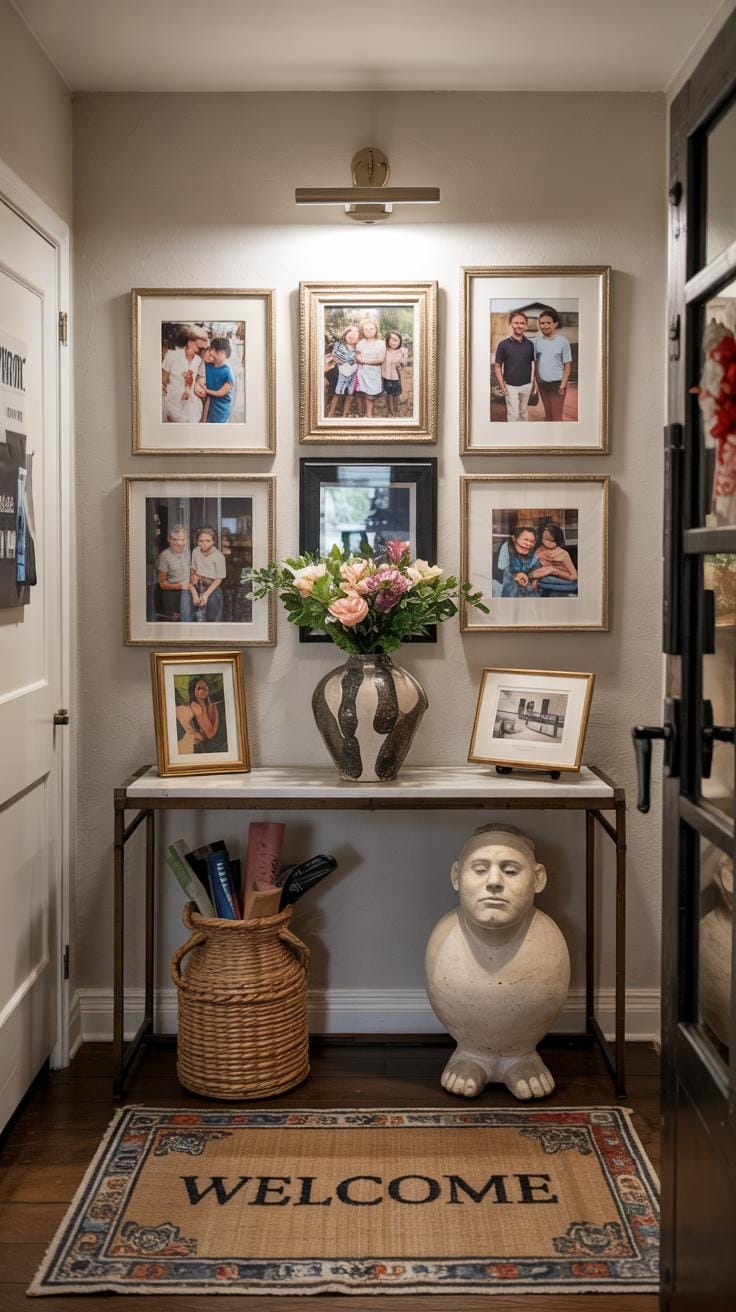Introduction
Your home’s entrance sets the tone for the entire space. A well-designed foyer invites guests in warmly and reflects your style. Modern foyer designs focus on combining functionality with sleek aesthetics to make a lasting first impression.
Creating a modern entrance involves careful planning. It requires balancing space, light, and décor to meet practical needs while keeping the look fresh and contemporary. This article guides you through design concepts that can transform your foyer into an attractive and useful entry point for your home.
Understanding the Role of Your Foyer
Your foyer is the first space people see when they enter your home. It gives an immediate impression of who you are and sets the tone for what’s inside. How does your entrance speak about your style? Does it feel warm and inviting or sleek and modern?
A foyer is more than just a hallway. It acts as a buffer between the outside world and your personal space. It provides a spot where guests can comfortably transition from outdoor wear to indoor comfort. Practical storage solutions here keep shoes, coats, and bags organized, helping maintain order throughout your home.
Balancing looks and practicality matters. Too much clutter at the door feels messy, while a barren space can feel cold. Thoughtful design gives you a welcoming area that works day to day and shows off your style at the same time. How will you make this first space both useful and memorable?
Purpose and Functionality
A foyer needs to work hard in a small footprint. It stores coats, shoes, umbrellas, and sometimes bags. Having designated places for these items keeps the rest of your home clean and tidy. Could you add hooks or cubbies to hold everyday essentials?
This space is also where you greet guests. Offering a bench or comfortable surface invites visitors to pause and feel welcomed. It creates a smooth shift from outside to inside, especially on busy or rainy days.
Think about what items you use as soon as you come home. Can your foyer hold those essentials without overcrowding? Efficient use of space is vital. What could you remove, add, or rearrange to optimize this entry point?
Design Impact on Home Atmosphere
The foyer sets the mood for the entire house. Choosing the right colors can warm up a small space or make it feel brighter and more open. Soft lighting adds comfort and guides guests inside. Have you tried layering lighting with lamps, overhead fixtures, or wall sconces?
Decor choices matter too. A well-placed mirror reflects light and opens the space visually. Artwork or plants bring personality and life without overwhelming the entryway. Think about what makes you feel calm or energized. How can you use these elements to create an inviting entry?
Every detail in your foyer influences how visitors perceive your home. When art, light, and color work together, the space feels intentional and welcoming. How will you design your foyer to welcome friends and family with style and ease?
Choosing a Style That Matches Your Home
Overview of Modern Styles
Minimalism relies on clean lines, neutral tones, and simple furniture. It avoids clutter and favors open space. Walls are often white or gray, paired with sleek finishes like glass or steel.
Scandinavian style highlights light wood, cozy textiles, and a soft color palette with whites, pastels, and muted blues. It mixes function with warmth, using natural materials such as wool and linen.
Industrial design uses raw elements like exposed brick, metal fixtures, and concrete. Colors lean toward darker grays, blacks, and browns. Furniture is sturdy and functional, often with a vintage or repurposed look.
Each style creates a different mood. Minimalism feels airy and clean. Scandinavian brings warmth and comfort. Industrial offers rugged, urban appeal. Your foyer can reflect these tones while inviting guests professionally and authentically.
Achieving Style Cohesion
To create harmony, match your foyer’s color palette with the adjacent rooms. Use similar or complementary shades on walls, floors, or accents.
Textures should flow smoothly. For example, if your living room has soft fabrics, carry some cushions or a rug with a related texture into the foyer.
Shapes and furniture lines matter too. A sleek console table pairs well with minimalist or Scandinavian styles but might clash with industrial decor. Choose pieces that connect visually to other spaces.
Ask yourself: How will your foyer look from nearby rooms? Does it feel like a natural extension or a separate space? Consistency in colors, textures, and forms will create a confident entrance that blends well with your home’s story.
Maximizing Space in Small Foyers
Small foyer areas require smart planning to remain welcoming and efficient. You want to avoid overcrowding while making the most of every inch. Clear pathways allow guests to enter smoothly and help you maintain a tidy look. Consider how each element in the space serves a purpose before including it.
Choosing the right furniture helps you save space without sacrificing style. Look for pieces that fit close to the wall or tuck neatly under surfaces. Use vertical space to add storage and keep floors open.
Keeping essentials easy to reach while storing away less-used items creates a practical environment. Can your entryway handle daily items like keys, shoes, and bags without looking messy? Thoughtful organization keeps clutter off surfaces, preserving a clean, modern feel.
Space-saving Furniture Choices
Compact furniture suits small foyers best. Wall-mounted shelves hold small items and decorative accents without taking floor space. Narrow benches offer a place to sit and can double as shoe storage underneath.
Choose multifunctional pieces, such as an ottoman with hidden storage inside. Folding or stackable chairs can appear only when needed. What pieces do you truly use in your entryway, and which ones occupy space without purpose?
Pick furniture with simple designs and slim profiles to keep the area feeling open. Avoid bulky or heavy pieces that reduce movement and add visual clutter.
Organized Storage Solutions
Hooks mounted near the door provide a place to hang coats, bags, and hats instantly. Use cubbies or small shelves for shoes and mail to avoid piles on the floor or counters. Hidden storage behind doors or under benches conceals items without limiting access.
Labels or designated spots for each type of item prevent messes from building up. How often do you clean or reorganize your foyer? Regularly clearing out unnecessary items keeps the space functional and neat.
Wire baskets and bins within cubbies help to gather smaller items like gloves or scarves together. Keeping everyday essentials visible yet organized saves time and reduces stress during busy mornings.
Lighting Design for a Bright and Inviting Entrance
Lighting sets the mood in your foyer. It helps guests feel welcome while making the space practical for everyday use. Good lighting improves visibility and highlights design features. You want an entrance that feels open and warm from the moment you step inside.
Think about light in layers rather than one source. Combine different types to create a balanced effect. Natural light softens the space during the day, while artificial light takes over at night or on cloudy days. The right fixtures and their placement can enhance colors, textures, and shapes in your foyer.
Have you thought about how lighting could change the first impression of your home? Consider lighting that draws attention to your décor or architectural details. This makes your entrance more interesting and inviting while serving practical needs.
Utilizing Natural and Artificial Light
Maximize natural light by using windows or glass doors in your foyer. These allow sunlight to fill the space, which boosts mood and visibility without extra energy use. If privacy is a concern, frosted or textured glass offers light without full exposure.
For times when sunlight is limited, choose artificial lights that blend well with your natural sources. Ceiling lights, wall sconces, or pendant lamps work well for evening use. Aim for bulbs with a warm color temperature around 2700K to 3000K for a cozy but bright feel.
Think about placement carefully. A fixture near your door or mirror improves function and style. What kind of lighting do you prefer when coming home after dark? Finding the right mix can turn your foyer into a stylish, useful space regardless of the time of day.
Layered Lighting Techniques
Using layers of light adds depth to your foyer and keeps it from feeling flat. Start with ambient lighting to fill the room with soft, even light. Recessed lights, flush mounts, or chandeliers offer good overall illumination.
Task lighting helps you complete activities like unlocking the door or checking your appearance. A wall-mounted fixture beside a mirror or a small table lamp on a console works well here. Think about placing lights where you need focused brightness.
Accent lighting highlights artwork, plants, or architectural details. Use spotlights or LED strip lights to draw attention to these features. Layered lighting lets you control the atmosphere with flexibility—bright for busy moments, subtle for calm welcomes.
Incorporating Functional Furniture in Your Foyer
Your foyer sets the tone for your home and needs furniture that balances style with daily needs. Choosing pieces that serve multiple purposes can keep this small space organized and welcoming. Think about seating that helps guests and family members tie their shoes comfortably. Sturdy benches with material that cleans easily save effort after busy days. When you consider tables, select ones with enough surface to hold keys, wallets, and mail. These surfaces prevent clutter from piling up on other areas of the home.
Durability matters. Your foyer furniture should stand up to frequent use and occasional dirt. Materials like treated wood, metal frames, or tough fabric blends work well. Avoid delicate finishes that show wear fast. Keeping furniture simple in design helps maintenance and fits different décor shifts. How could your foyer furniture make daily routines smoother and your home feel more inviting?
Seating and Surface Areas
Not every foyer can hold large chairs or sofas, so compact benches, stools, or slim chairs fit best. A bench with storage underneath offers seating and space-saving benefits. Choose stools without backs for easy access if you need to pull them out quickly.
Surfaces matter for routine items. A narrow console table offers a place to drop keys and mail while stepping inside. Look for tables with raised edges or small bowls to keep items from slipping off. A surface near the door serves as a visual guide, reminding you where essentials belong. Could a simple piece like a slim bench or console table reduce morning chaos in your foyer?
Storage Units and Cabinets
Storage furniture in a foyer keeps clutter from spreading into living areas. Units with built-in drawers, cabinets, or open shelves allow you to hide shoes, umbrellas, and bags neatly. Low cabinets double as seating if topped with cushions, making space work harder for you.
Choose storage that fits the scale of your foyer without overwhelming it. Wall-mounted shelves or floating cabinets free up floor space while keeping items accessible. Materials that clean easily help maintain a fresh look despite heavy daily use. Think about what items tend to gather near your entrance. How could your storage choices keep them organized and easy to find?
Selecting Colors and Materials to Enhance Your Foyer
Your choice of colors and materials can change how your foyer feels and functions. Light shades like whites, creams, or soft grays make small foyers seem bigger by reflecting more light. If your entrance is spacious, darker or richer tones can add warmth without closing the space in. Consider how colors affect mood. Calmer colors like blues or greens invite relaxation, while brighter ones like yellows or reds offer energy and a bold statement.
Materials play a key role too. Hard-wearing surfaces such as stone or tile handle heavy foot traffic well. Wood brings warmth but needs sealing to resist scratches and moisture. Mixing smooth finishes like glass with rough textures like woven rugs creates visual variety without overwhelming the senses. Durability matters because your foyer faces daily wear. Choose materials you can keep clean and repair easily. Think about how the textures and colors work together to create a balanced, welcoming space.
Color Schemes for Modern Foyers
Neutral colors provide a solid base for any modern foyer. Light grays, soft beiges, and off-white shades keep the area bright and adaptable. Do you want to make a statement? Add a pop of color, like a teal bench or a vibrant piece of wall art. That spot of color can lift the mood and draw focus. Remember, colors influence how you feel and how big the space looks. Using cooler tones tends to expand the space, while warm colors bring a cozy feeling. Think about how you want your foyer to make you feel every time you enter your home.
Choosing Durable and Stylish Materials
Wood, metal, glass, and stone are smart choices for foyer materials because they combine beauty with function. Wooden floors or benches add a natural touch but require finishing to protect against scratches. Metal accents, like door handles or lighting fixtures, ensure longevity and give a sleek edge to your design. Glass surfaces, such as mirrors or entry tables, keep the foyer feeling open and bright while providing practical use. Stone or tile floors stand up to heavy traffic and dirt, especially if you place rugs to protect them. When picking materials, ask yourself how much foot traffic your foyer gets and how much time you want to spend cleaning and maintaining.
Adding Personal Touches with Dcor and Art
Your foyer sets the first impression of your home, and personal touches make it feel welcoming without filling it up. Choose a few meaningful art pieces that reflect your style. A single statement painting or a small gallery wall can add character without crowding walls. Mirrors serve a dual purpose: they enhance light and give the illusion of more space while acting like décor elements.
A well-placed plant can bring life and freshness to the area. Select plants that thrive indoors and fit the size of your foyer, such as snake plants or pothos. Rugs add warmth underfoot and introduce color or pattern. Keep them proportionate to your space to avoid overwhelming the room. Personal items like a favorite sculpture or a unique vase can make guests feel invited and convey your personality. What small details tell your story when someone walks through your door?
Art and Mirrors for Visual Appeal
Pick artwork that matches your foyer’s modern aesthetic without crowding the wall. Abstract prints or simple framed photos work well. Consider scale—large pieces can anchor the space, while smaller sets create visual rhythm. Mirrors expand the room visually, reflecting natural light and creating depth, especially in compact foyers.
Choose mirror shapes that suit your style. Round mirrors soften straight lines common in modern designs, while geometric shapes add structure. Position mirrors opposite windows when possible to bounce light across the space. Adding art and mirrors thoughtfully enhances the foyer’s style and opens up the entrance to feel bright and inviting.
Plants and Textiles for Warmth
Plants soften modern foyers and bring a touch of nature indoors. Use tall plants near corners or small succulents on a console table. Their greenery adds color without dominating the space. Textiles like rugs introduce warmth and texture. Pick rugs in natural fibers or simple patterns that complement your color scheme.
Rugs reduce echo and make the entry more comfortable to step into. If your foyer includes a bench or seating area, cushions in coordinating fabrics invite guests to pause. These elements add layers that make the space feel lived-in and cozy without clutter. How can you use plants and textiles to balance style and comfort in your foyer?
Smart Technology Integration for Modern Foyers
Your foyer sets the tone for your home’s entrance. Smart technology can enhance this space by making it both welcoming and practical. Keyless entry systems offer effortless access, allowing you to unlock your door with a code, fingerprint, or phone app. This reduces the hassle of carrying keys and improves security. Smart lighting can automatically turn on when you enter or adjust based on the time of day, creating a warm and safe atmosphere.
Security cameras and motion sensors provide peace of mind without cluttering the space. These tools work quietly in the background to alert you of any unusual activity. When adding technology, consider how each feature serves your daily life without making the entrance feel crowded or tech-heavy. How can you blend convenience with style in your foyer? Thoughtful tech choices make your home’s first impression strong and secure.
Convenience Through Smart Features
Smart locks simplify your routine by eliminating the need for physical keys. You can grant temporary access to guests or service workers through your phone. Automated lighting systems adjust brightness as you enter, improving safety and comfort. Imagine returning home with your hands full, and the lights automatically brighten your path without you touching a switch.
Voice control can further streamline your experience. You might ask your smart assistant to turn on hallway lights or check if the front door is locked. These technologies make daily tasks easier, reducing stress and saving time. Which smart features would turn your foyer into a smooth and efficient entry point?
Balancing Technology and Design
Integrating technology should not overpower your foyer’s design. Choose devices that blend with your décor or stay hidden from plain sight. For example, slim smart switches or recessed sensors keep walls neat. Select lighting fixtures that match your style but have built-in smart capabilities.
User-friendly interfaces prevent frustration and keep visitors impressed with seamless functionality. Avoid bulky gadgets that disrupt the flow or create visual clutter. Can technology become part of your foyer’s aesthetic instead of standing out? Careful placement and design-conscious choices allow your entrance to remain stylish and welcoming.
Maintaining Your Modern Foyer Over Time
Your modern foyer welcomes guests and sets the tone for your home’s style. Keeping it clean and organized helps maintain that first impression. Make tidying up a routine by clearing clutter daily and putting items like shoes and bags in designated spots. This prevents chaos and makes the area feel inviting. Pay attention to furniture care by using soft cloths for dusting and cleaners made for the materials, such as wood polish or glass spray, depending on your pieces.
Materials like stone or tile need occasional deep cleaning to remove dirt build-up and maintain shine. Regularly check for small damages like scratches or loose hardware and fix them quickly to avoid bigger issues. Updating your foyer’s look doesn’t mean large changes. Small shifts keep the space current and welcoming without breaking your routine. How often do you reassess your entry space to keep it both practical and stylish?
Cleaning and Upkeep Tips
Cleaning your foyer furniture depends on the material. For wooden benches or consoles, use a gentle wood cleaner and a soft cloth to avoid scratches. Upholstered seats benefit from vacuuming and spot cleaning to remove dirt and stains. Glass surfaces require streak-free cleaners applied with microfiber cloths.
Tile or stone floors demand mopping with pH-neutral cleaners to keep grout lines bright and surfaces smooth. Each season, look for dust on vents and light fixtures to improve air quality and brightness. Winter months bring mud and salt stains, so wipe floors daily during cold weather to shield materials. Schedule deep cleans quarterly to keep every element fresh and well-maintained.
Refreshing the Space Periodically
Rearranging furniture breathes new life into your foyer without big expenses. Try moving a console table or swapping a bench for chairs to change the flow. Replace decorative items like rugs, artwork, or vases to update the look. Think about upgrading lighting with modern fixtures or adding plants for natural warmth.
Small upgrades, such as new hooks or a mirror, keep the space practical and stylish. Consider seasonal color changes in cushions or mats to reflect different moods. How would a fresh layout or a new decor piece change the way your foyer feels when you walk in? These simple shifts prevent your entrance from feeling tired or out of date.
Conclusions
Modern foyer design enhances both the look and utility of your entrance. Focusing on clean lines, smart storage, and effective lighting helps you achieve a welcoming space that works well every day. Pay attention to the flow between the foyer and your home’s interior to keep a cohesive feel.
Consider your preferences and lifestyle when choosing foyer elements. Thoughtful choices in furniture, colors, and accessories bring balance and comfort. Updating your entrance with these design ideas can improve your home’s appeal and create a positive experience for all who enter.

